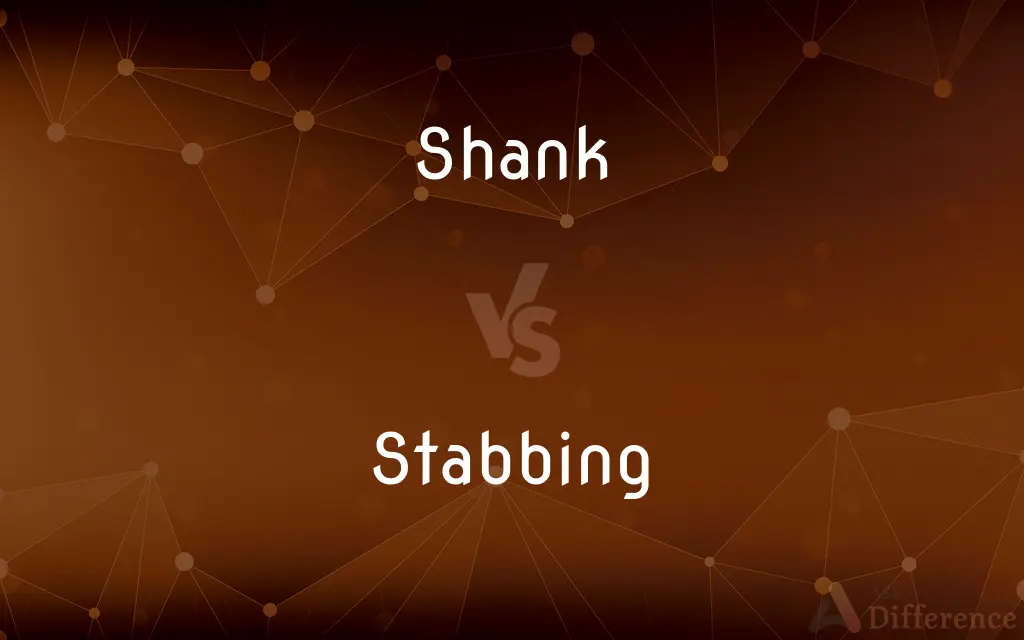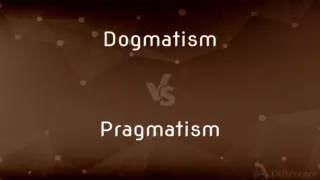Shank vs. Stabbing — What's the Difference?
Edited by Tayyaba Rehman — By Maham Liaqat — Updated on April 2, 2024
Shank refers to a homemade knife or sharp tool, while stabbing is the action of piercing someone with a sharp object.

Difference Between Shank and Stabbing
Table of Contents
ADVERTISEMENT
Key Differences
A shank is often improvised from materials at hand, used as a makeshift weapon, primarily in prisons. It's crafted from anything sturdy enough to hold a point or edge, like metal scraps or plastic. On the other hand, stabbing is the act of piercing or cutting someone with a sharp object. It doesn't specify the weapon used, focusing instead on the action and its violent intent.
While a shank is characterized by its origin and makeshift nature, a stabbing describes the method of assault regardless of the weapon. A stabbing can be carried out with any sharp object, including knives, shanks, or even broken glass, emphasizing the action over the tool.
The creation of a shank is driven by necessity and resourcefulness, often reflecting the ingenuity of individuals in restricted environments. Stabbing, however, is a deliberate act of violence, highlighting the perpetrator's intent to harm rather than the creativity behind the weapon's creation.
Shanks are typically hidden and can be surprisingly deadly, fashioned with a specific purpose in mind. Stabbings, by their nature, are sudden and brutal, aiming to inflict maximum damage in the shortest amount of time possible.
The discussion around shanks often revolves around prison security and inmate ingenuity. In contrast, conversations about stabbing are more focused on criminal justice, violence prevention, and public safety.
ADVERTISEMENT
Comparison Chart
Definition
A homemade knife or tool.
The action of piercing someone with a sharp object.
Origin
Crafted from available materials.
Can be executed with any sharp object.
Context
Often associated with prisons.
Associated with violent acts.
Focus
On the makeshift nature of the weapon.
On the act and intent of violence.
Discussion Topics
Security measures, inmate ingenuity.
Criminal justice, violence prevention.
Compare with Definitions
Shank
A homemade knife or weapon, especially in prison settings.
The inmate crafted a shank from a toothbrush.
Stabbing
An intentional act of thrusting a sharp object into someone.
He was arrested for the stabbing of a store clerk.
Shank
An improvised tool for cutting or stabbing.
He fashioned a shank from a piece of scrap metal.
Stabbing
The act of piercing or cutting with a pointed object.
The stabbing left the victim in critical condition.
Shank
A sharp, pointed object made from non-traditional materials.
The guard found a shank hidden in the cell.
Stabbing
A method of assault characterized by the penetration of a sharp object.
The detective concluded the case as a stabbing.
Shank
Any sharp object created with the intent to be used as a weapon.
Using a broken piece of glass, he made a shank.
Stabbing
A violent attack involving a sharp weapon.
The police are investigating a stabbing near the park.
Shank
An object adapted for violent purposes.
The shank was cleverly disguised as a pen.
Stabbing
The use of a knife or similar tool to inflict injury.
Stabbing incidents have risen in the city.
Shank
A person's leg, especially the part from the knee to the ankle
The old man's thin, bony shanks showed through his trousers
Stabbing
A stabbing is penetration or rough contact with a sharp or pointed object at close range. Stab connotes purposeful action, as by an assassin or murderer, but it is also possible to accidentally stab oneself or others.
Shank
A long, narrow part of a tool connecting the handle to the operational end
Gouges vary in the amount of curve or sweep on the cutting edge and the form of the shank
Stabbing
To pierce or wound with or as if with a pointed weapon.
Shank
A part or appendage by which something is attached to something else, especially a wire loop attached to the back of a button.
Stabbing
To plunge (a pointed weapon or instrument) into something.
Shank
The narrow middle of the sole of a shoe
A rigid leather boot with a full shank
Stabbing
To make a thrusting or poking motion at or into
Stabbed the air with his fingers.
Shank
A makeshift knife fashioned from a sharp item such as broken glass or a razor
He used a shank to threaten a guard and steal his uniform
Stabbing
To thrust with or as if with a pointed weapon
Stabbed at the food with her fork.
Shank
An act of striking the ball with the heel of the club
He hit a shank with his tee shot and took double bogey
Stabbing
To inflict a wound with or as if with a pointed weapon.
Shank
Strike (the ball) with the heel of the club
I shanked a shot and hit a person on a shoulder
Stabbing
A thrust with a pointed weapon or instrument.
Shank
Slash or stab (someone), especially with a makeshift knife
I got shanked with a broken bottle
My friend pulled a knife and shanked him
Stabbing
A wound inflicted with or as if with a pointed weapon.
Shank
The part of the human leg between the knee and ankle.
Stabbing
A sudden piercing pain.
Shank
A corresponding part in other vertebrates.
Stabbing
An attempt; a try
Made a stab at the answer.
Shank
The whole leg of a human.
Stabbing
(of pain) Sharp, intense.
Too much running gives me a stabbing pain in the chest.
Shank
A leg or leglike part.
Stabbing
An incident in which a person is stabbed.
A stabbing took place in the alley last night.
The hospital receives many victims of stabbings.
Shank
A cut of meat from the leg of a steer, calf, sheep, or lamb.
Stabbing
Present participle of stab
Shank
The long narrow part of a nail or pin.
Stabbing
Causing physical or especially psychological injury;
A stabbing remark
Few experiences are more traumatic than losing a child
Wounding and false charges of disloyalty
Shank
A stem, stalk, or similar part.
Stabbing
As physically painful as if caused by a sharp instrument;
A cutting wind
Keen winds
Knifelike cold
Piercing knifelike pains
Piercing cold
Piercing criticism
A stabbing pain
Lancinating pain
Shank
(Nautical) The stem of an anchor.
Shank
The long shaft of a fishhook.
Shank
The part of a tobacco pipe between the bowl and stem.
Shank
The shaft of a key.
Shank
The narrow section of the handle of a spoon.
Shank
(Printing) The section of a body of type between the shoulder and the foot.
Shank
The narrow part of the sole of a shoe under the instep.
Shank
A piece of material, such as metal, that is used to reinforce or shape this part of a shoe.
Shank
A projection, such as a ring, on the back of a button by which it is sewn to cloth.
Shank
See tang1.
Shank
The part of a tool, such as a drill, that connects the functioning head to the handle.
Shank
The latter or remaining part, especially of a period of time.
Shank
The early or primary part of a period of time
The shank of the evening.
Shank
(Slang) A knife or other sharp, pointed implement, especially one that has been fashioned from something else; a shiv.
Shank
To hit (a golf ball) with the heel of the club, causing the ball to veer in the wrong direction.
Shank
(Slang) To stab (a person) with a sharp, pointed implement.
Shank
The part of the leg between the knee and the ankle.
Shank
Meat from that part of an animal.
Shank
A redshank or greenshank, various species of Old World wading birds in the genus Tringa having distinctly colored legs.
Shank
A straight, narrow part of an object, such as a key or an anchor; shaft; stem.
Shank
The handle of a pair of shears, connecting the ride to the neck.
Shank
The center part of a fishhook between the eye and the hook, the 'hook' being the curved part that bends toward the point.
Shank
A protruding part of an object, by which it is or can be attached.
Shank
The metal part on a curb bit that falls below the mouthpiece, which length controls the severity of the leverage action of the bit, and to which the reins of the bridle are attached.
Shank
(golf) A poorly played golf shot in which the ball is struck by the part of the club head that connects to the shaft.
Shank
(slang) An improvised stabbing weapon.
Shank
A loop forming an eye to a button.
Shank
(architecture) The space between two channels of the Doric triglyph.
Shank
(metalworking) A large ladle for molten metal, fitted with long bars for handling it.
Shank
The body of a type; between the shoulder and the foot.
Shank
(shoemaking) The part of the sole beneath the instep connecting the broader front part with the heel.
Shank
Flat-nosed pliers, used by opticians for nipping off the edges of pieces of glass to make them round.
Shank
The end or remainder, particularly of a period of time.
Shank
The main part or beginning of a period of time.
The shank of the morning
Shank
To travel on foot.
Shank
(slang) To stab, especially with an improvised blade.
Shank
(slang) To remove another's trousers, especially in jest; to depants.
Shank
To misstrike the ball with the part of the club head that connects to the shaft.
Shank
To hit or kick the ball in an unintended direction.
Shank
(intransitive) To fall off, as a leaf, flower, or capsule, on account of disease affecting the supporting footstalk; usually followed by off.
Shank
To provide (a button) with a shank loop forming an eye.
Shank
(shoemaking) To apply the shank to a shoe, during the process of manufacturing it.
Shank
(slang) Bad.
Shank
See Chank.
Shank
The part of the leg from the knee to the foot; the shin; the shin bone; also, the whole leg.
His youthful hose, well saved, a world too wideFor his shrunk shank.
Shank
Hence, that part of an instrument, tool, or other thing, which connects the acting part with a handle or other part, by which it is held or moved.
Shank
The space between two channels of the Doric triglyph.
Shank
A large ladle for molten metal, fitted with long bars for handling it.
Shank
The body of a type.
Shank
The part of the sole beneath the instep connecting the broader front part with the heel.
Shank
A wading bird with long legs; as, the green-legged shank, or knot; the yellow shank, or tattler; - called also shanks.
Shank
Flat-nosed pliers, used by opticians for nipping off the edges of pieces of glass to make them round.
Shank
To fall off, as a leaf, flower, or capsule, on account of disease affecting the supporting footstalk; - usually followed by off.
Shank
A cut of meat (beef or veal or mutton or lamb) from the upper part of the leg
Shank
The part of the human leg between the knee and the ankle
Shank
Cylinder forming a long narrow part of something
Shank
Cylinder forming the part of a bolt between the thread and the head
Shank
Cylinder forming the part of a bit by which it is held in the drill
Shank
The narrow part of the shoe connecting the heel and the wide part of the sole
Shank
Lower part of the leg extending from the hock to the fetlock in hoofed mammals
Shank
A poor golf stroke in which the heel of the club hits the ball
Shank
Hit (a golf ball) with the heel of a club, causing the ball to veer in the wrong direction
Common Curiosities
Is stabbing only done with knives?
No, stabbing can be done with any sharp object, including knives, broken glass, or a shank.
Can any sharp object be a shank?
Yes, any sturdy, sharp object fashioned with the intent to be used as a weapon can be considered a shank.
What does stabbing mean?
Stabbing refers to the act of piercing or cutting someone with a sharp object.
What is a shank?
A shank is an improvised knife or sharp object, often made in prisons from available materials.
What motivates someone to create a shank?
Motivations include self-defense, the intent to attack, or as a means of intimidation.
How do law enforcement agencies view stabbing incidents?
Stabbing incidents are viewed as violent crimes and are investigated thoroughly by law enforcement agencies.
Are there preventive measures against stabbing?
Yes, preventive measures include increased public awareness, law enforcement, and policies aimed at reducing violence.
Where are shanks commonly found?
Shanks are most commonly found in prisons, crafted by inmates.
Can stabbing be accidental?
While most stabbings are intentional, accidental stabbings can occur, though they are less common.
What materials are commonly used to make a shank?
Common materials include metal scraps, plastic, glass, and even hardened paper or toothbrushes.
How can one differentiate a stabbing wound from other types of injuries?
A stabbing wound is typically characterized by a deep, narrow puncture or cut, often with distinct entry and exit points.
What impact do stabbing incidents have on communities?
Stabbing incidents can increase fear, reduce the sense of community safety, and require significant police resources.
What is the primary purpose of a shank?
The primary purpose of a shank is to serve as a weapon, either for self-defense or aggression within confined environments.
How is stabbing treated in the legal system?
Stabbing, being a form of assault or attempted murder, is treated seriously in the legal system and can result in significant penalties.
What are the consequences of being caught with a shank in prison?
Being caught with a shank in prison can lead to additional charges, solitary confinement, or extended sentences.
Share Your Discovery

Previous Comparison
Conceptual vs. Practical
Next Comparison
Dogmatism vs. PragmatismAuthor Spotlight
Written by
Maham LiaqatEdited by
Tayyaba RehmanTayyaba Rehman is a distinguished writer, currently serving as a primary contributor to askdifference.com. As a researcher in semantics and etymology, Tayyaba's passion for the complexity of languages and their distinctions has found a perfect home on the platform. Tayyaba delves into the intricacies of language, distinguishing between commonly confused words and phrases, thereby providing clarity for readers worldwide.














































